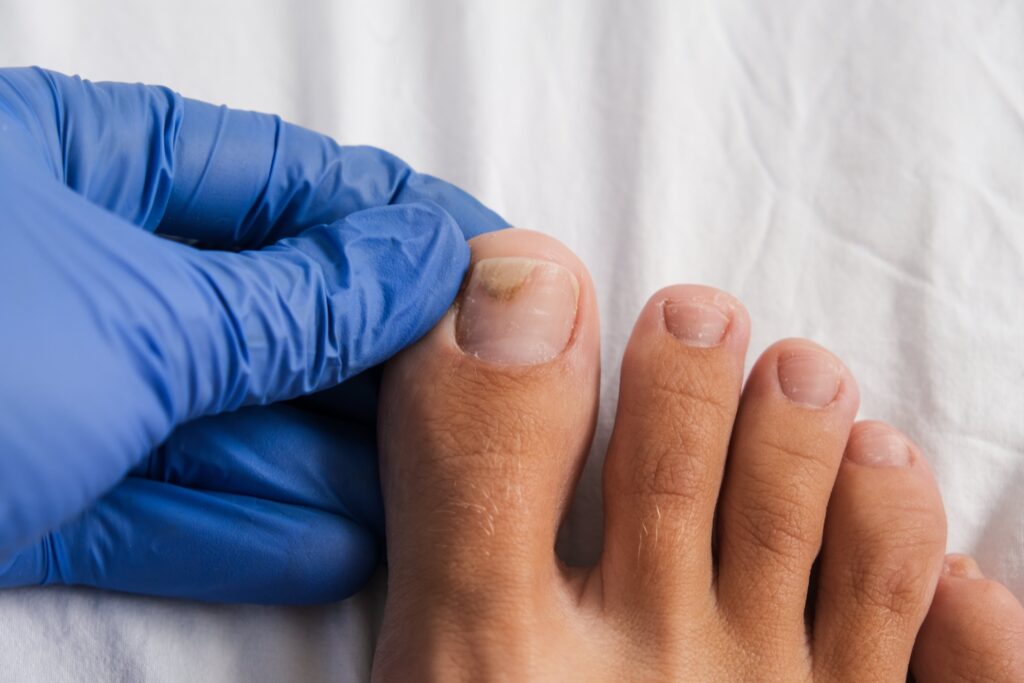Toenail fungus, also known as onychomycosis, is a common condition that affects approximately 14% of the global population at any given time. This condition can cause thickened, discolored, or brittle nails, often leading to discomfort and self-consciousness. While medical treatments are available, many people prefer natural or at-home remedies to address this stubborn problem.
Below, we explore effective, research-backed natural remedies for toenail fungus, tips for prevention, and when to consult a specialist. For residents in Minnesota, Pinnacle Foot and Ankle Clinics in Edina and Burnsville are conveniently located near Minneapolis and offer expert care for all foot and ankle conditions, including toenail fungus. Before trying any at-home remedies, we encourage you to consult with our podiatrists to create a treatment plan which works for you and will effectively resolve your fungal nails.
What Causes Toenail Fungus?
Toenail fungus is caused by various types of fungi, including dermatophytes, yeasts, and molds. These microorganisms thrive in warm, moist environments, making locker rooms, public pools, and sweaty shoes prime breeding grounds. Risk factors include:
- Wearing closed-toe shoes for prolonged periods
- Poor foot hygiene
- Immune system disorders
- Conditions such as diabetes or athlete’s foot
Addressing these risk factors can help prevent recurrence, but for existing infections, remedies are essential.
Top Natural Remedies for Toenail Fungus
Tea Tree Oil
Tea tree oil, derived from the leaves of the Melaleuca alternifolia tree, has natural antifungal and antiseptic properties. A study published in the Journal of Family Practice found that 100% tea tree oil applied twice daily cleared nail fungus in 18% of participants after six months, with noticeable improvement in 56% of cases.
How to Use:
- Mix a few drops of tea tree oil with a carrier oil (e.g., coconut or olive oil).
- Apply directly to the affected nail using a cotton swab.
- Repeat twice daily for several weeks.
Apple Cider Vinegar
Apple cider vinegar (ACV) creates an acidic environment that may prevent fungus from spreading. Although evidence is primarily anecdotal, its antifungal properties are well-documented in various studies.
How to Use:
- Mix equal parts of ACV and water in a basin.
- Soak your feet for 15-20 minutes daily.
- Dry thoroughly after soaking.
Garlic
Garlic contains allicin, a compound with potent antifungal properties. Garlic extract effective against fungal strains causing onychomycosis.
How to Use:
- Crush a few garlic cloves to release their juice.
- Apply the paste to the affected nail.
- Cover with a bandage and leave for 30 minutes.
- Wash off and repeat daily.
Baking Soda
Baking soda can help absorb moisture, reducing fungal growth. A study in the Journal of Fungi highlighted its antifungal properties against dermatophytes.
How to Use:
- Mix baking soda with water to create a paste.
- Apply to the nail and surrounding skin.
- Let it sit for 10-15 minutes before rinsing off.
- Use daily for best results.
Coconut Oil
Coconut oil contains caprylic acid, which can penetrate fungal cell walls and inhibit growth. Its moisturizing properties also support nail health.
How to Use:
- Apply a thin layer of organic coconut oil to the affected nail.
- Massage gently and leave it on.
- Repeat 2-3 times daily.
Get Back on Your Feet!
Preventing Toenail Fungus
Preventing toenail fungus is as important as treating it. Here are some practical tips:
- Practice Good Foot Hygiene: Wash and dry your feet daily, especially between the toes.
- Choose Breathable Footwear: Opt for shoes made of materials that allow airflow.
- Change Socks Regularly: Avoid wearing damp socks for extended periods.
- Use Antifungal Powder: Sprinkle antifungal powder in shoes to reduce moisture.
- Avoid Walking Barefoot in Public Areas: Use flip-flops in locker rooms and around pools.
- Trim Nails Properly: Cut nails straight across to avoid ingrown nails, which can harbor fungi.
When to Seek Professional Help
While natural remedies can be effective for mild cases, severe or persistent fungal infections require medical attention. Signs that it’s time to consult a podiatrist include:
- Nail pain or discomfort
- Thickened, distorted nails that impede daily activities
- Spreading infection to other nails or skin
- Lack of improvement after several months of at-home treatment
For those in Minnesota, Pinnacle Foot and Ankle Clinics in Edina and Burnsville are conveniently located near Minneapolis, making expert care easily accessible. Our team specializes in diagnosing and treating toenail fungus using advanced medical and laser therapies.
Schedule an Appointment at Our Office
Toenail fungus can be frustrating, but it’s manageable with persistence and the right approach. Natural remedies like tea tree oil, apple cider vinegar, and garlic offer effective, low-cost solutions for mild infections. However, prevention and professional care are key to maintaining healthy, fungus-free nails.
If you’re struggling with toenail fungus, contact us for expert guidance and treatment options. Conveniently located near Minneapolis, we’re here to help you put your best foot forward!


